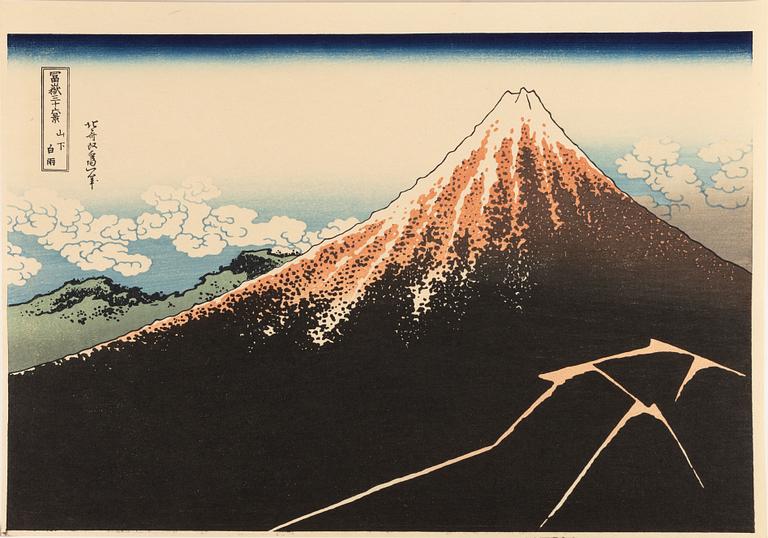Katsushika Hokusai
Katsushika Hokusai, after, five woodblock prints in colour, second half of the 20th Century.
"Storm below the summit (Sanka hakuu), also known as Black Fuji". from the series Thirty-six views of Mount Fuji (Fugaku sanjūrokkei). Image size: 25 x 37.5 cm.
"Mount Fuji from Kanaya on the Tōkaidō Road (Tōkaidō Kanaya no Fuji), from the series Thirty-six Views of Mount Fuji (Fugaku sanjūrokkei). Image size: 25.5 x 37.8 cm.
"Senju in Musashi Province (Bushū Senju)". from the series Thirty-six Views of Mount Fuji (Fugaku sanjūrokkei). Image size: 25 x 37 cm.
"Poem by Ariwara no Narihira (Ariwara no Narihira Ason)"
from the series The Hundred Poems (By the Hundred Poets) as Told by the Nurse (Hyakunin isshu uba ga etoki). Image size: 25 x 37 cm.
"Under the Mannen Bridge at Fukagawa (Fukagawa Mannenbashi shita)". From the series Thirty-six Views of Mount Fuji (Fugaku sanjūrokkei). Image size: 25 x 37.8 cm.
Not framed. Minor wear. Partly with minor foxing.
Artist
Katsushika Hokusai (1760-1849) is considered one of the greatest artists in Japanese history, and one of the important masters of the Japanese woodblock print. He was the son of the mirror maker Nakajima Issai and was born in 1760 into a family of craftsmen where he reportedly started drawing as early as six years old. Trained as a woodcarver, Hokusai was an apprentice to the artist and printmaker Katsugawa Shunsho, but was forced to quit seven years later as he had his own ideas about art. Hokusai questioned the strict Japanese principles for images and tested new techniques and perspectives and was not recognized until his 40s. He created the series 'Fugaku sanju-rokkei' (Thirty-Six Views of Mount Fuji), between 1830-1832, over seventy years old. The series actually consists of 46 views, including the world famous 'Under the waves off Kanagawa'. Hokusai's pictures came to Europe, along with the works of other Japanese woodcut artists, in the latter part of the 19th century and came to influence many of the Western world's most important artists.
Read more








































